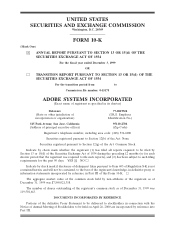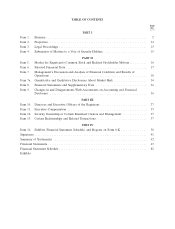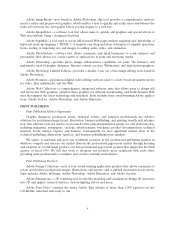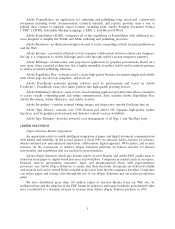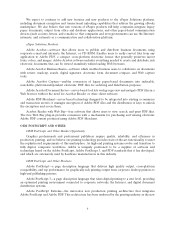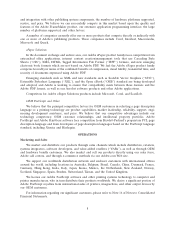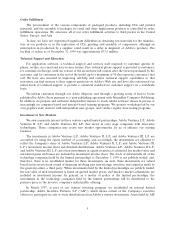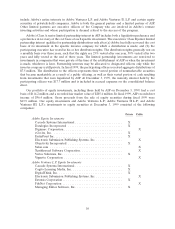Adobe 1999 Annual Report Download - page 3
Download and view the complete annual report
Please find page 3 of the 1999 Adobe annual report below. You can navigate through the pages in the report by either clicking on the pages listed below, or by using the keyword search tool below to find specific information within the annual report.Forward-Looking Statements
In addition to historical information, this Annual Report on Form 10-K contains forward-looking
statements that involve risks and uncertainties that could cause actual results to differ materially. Factors that
might cause or contribute to such differences include, but are not limited to, those discussed in the section
entitled ‘‘Management’s Discussion and Analysis of Financial Condition and Results of Operations—Factors
That May Affect Future Results of Operations.’’ You should carefully review the risks described in other
documents we file from time to time with the Securities and Exchange Commission, including the Quarterly
Reports on Form 10-Q to be filed in 2000. When used in this report, the words ‘‘expects,’’ ‘‘anticipates,’’
‘‘intends,’’ ‘‘plans,’’ ‘‘believes,’’ ‘‘seeks,’’ ‘‘estimates,’’ and similar expressions are generally intended to identify
forward-looking statements. You should not place undue reliance on the forward-looking statements, which
speak only as of the date of this Annual Report on Form 10-K. We undertake no obligation to publicly release
any revisions to the forward-looking statements or reflect events or circumstances after the date of this
document.
PART I
Item 1. Business
Founded in 1982, Adobe Systems Incorporated (‘‘Adobe’’ or the ‘‘Company’’) is a provider of graphic
design, publishing, and imaging software for Web and print production. We offer a market-leading line of
application software products for creating, distributing, and managing information of all types. We license
our industry-standard technologies to major hardware manufacturers, software developers, and service
providers, and offer integrated software solutions to businesses of all sizes. Our software runs on Microsoft
Windows, Apple Macintosh, Linux, and UNIX platforms.
Adobe was originally incorporated in California in October 1983 and was reincorporated in Delaware
in May 1997. We maintain executive offices and principal facilities at 345 Park Avenue, San Jose,
California 95110-2704. Our telephone number is 408-536-6000. We maintain a World Wide Web site at
www.adobe.com.
On September 16, 1999, Adobe’s Board of Directors announced a two-for-one stock split, effected in
the form of a stock dividend of our common stock for stockholders of record on October 4, 1999. The stock
dividend was paid on October 26, 1999. All share and per share amounts referred to in this Form 10-K
have been adjusted to reflect the stock split.
BUSINESS OVERVIEW
In 1984, Adobe developed the software that initiated desktop publishing. Today, we continue to be
uniquely positioned to make dramatic changes not only to how society creates visually rich information for
print and the Web, but also as to how it distributes and accesses that information electronically.
In the simplest of terms, Adobe helps people communicate better. By delivering powerful graphic
design, publishing, and imaging software for print and Web production, we help people express, share, and
manage their ideas in imaginative and meaningful new ways.
Our strategy is to address the needs of professional publishers, Web publishers, business publishers,
and consumers, as well as document intensive companies that are transitioning from paper to digital-based
processes and workflows. We execute on this strategy by delivering products that support industry
standards and that can be deployed on multiple computing environments, including Microsoft Windows,
Apple Macintosh, Linux, and UNIX.
2

